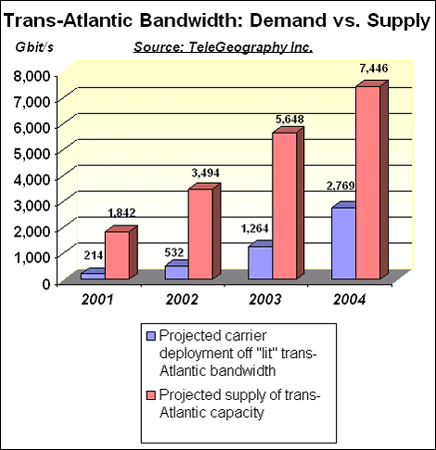Huge amounts of cable capacity are unused, but that's business as usual, says TeleGeography
April 25, 2001

Current plans to lay new cable systems under the Atlantic will result in a four-fold increase in potential capacity in the next four years, according to a recent report from research firm TeleGeography Inc..
Strangely, however, a lot of that capacity will remain unlit and unused.
TeleGeography’s figures indicate that a mere 11.6 percent of transatlantic cable capacity is actually in use this year and that a huge gap between supply and demand will continue for the foreseeable future. "An initial glance at the results of our analysis may frighten some investors, but a closer look will comfort others," says report author Tim Stronge in a press statement.
"An initial glance at the results of our analysis may frighten some investors, but a closer look will comfort others," says report author Tim Stronge in a press statement.
The frightening aspect of these figures is that they appear to indicate that service providers have overreacted to scare stories about Internet traffic volumes exploding. As a result, they may find it even tougher to raise money to continue increasing the capacity of their networks, and that might put a further squeeze on the whole telecom equipment industry.
The comforting aspect comes from taking a closer look at the economics of cable systems. Essentially, the expensive part of subsea DWDM (dense wavelength-division multiplexing) systems comprises the transponders used to “light” individual wavelengths. As a result, cable operators typically install the highest capacity DWDM systems available and then equip them with transponders as and when they sell capacity.
As DWDM technology has improved, cable operators have been putting in systems that can scale to larger and larger capacities in the belief that it doesn’t really cost them a lot extra to cater to the uncertainties of future traffic growth.
And that's a sensible thing to do. TeleGeography has predicted the amount of lit capacity by extrapolating past statistics. Although that’s as good as any method of forecasting the future, there’s really no way of knowing what will happen with Internet traffic volumes.
Although the gap between lit and overall cable capacity appears to widen over time, it narrows considerably in percentage terms, according to TeleGeography’s forecasts. This year’s lit capacity equates to 11.6 percent of the total, as already noted. In 2004, it reaches 37.2 percent.
- Peter Heywood, International Editor, and Mary Jander, Senior Editor, Light Reading http://www.lightreading.com
You May Also Like









